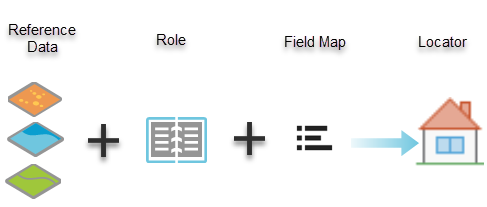One of the first processes in geocoding with your own data is creating a locator. Before you start creating a locator, it is helpful to learn about the major components and properties that go into creating one. Creating a locator involves selecting reference data, such as street centerlines, tax parcels, or building name layers, and the correct locator role for the reference data and mapping the appropriate data fields to the fields from the selected locator role or roles. A single locator can be created using multiple reference datasets and roles, which can be used to search for multiple types of locations at once.

Components of a locator
The major components for building a locator are defined in the sections below:
Primary reference data
The results of geocoding are as good as your primary reference data, which needs to include the geometry and attributes for the addresses and places you want to search for. For example, when searching for house number addresses, the reference data must contain the house number ranges, street names, or address attributes of the specific streets. Reference data can consist of the following spatial features:
- Addresses—Points, streets, parcels, building footprints
- Points of interest—Landmarks, place-names, buildings
- Populated places—Cities, regions, countries, postal codes
- Locations—Wells, parking meters, census tracts
Locator role
The locator role defines the type of data that is being used (parcel, street centerline, postal, point of interest, and so on) and provides the appropriate fields that should be used when building the locator and the information returned in the geocoding results. The primary locator roles provided with ArcGIS Pro will allow you to build the following types of locators:
- Point Address—A street address based on points that represent house and building locations. Includes Subaddress, which is based on points that represent house and building subaddress locations, such as suite, floor, and apartment.
- Street Address—A street address based on streets where the house number is interpolated from a range of numbers. Includes intersections, street name, and street extension.
- Point of Interest—Consists of administrative divisions, place-names, businesses, landmarks, and geographic features, for example, Starbucks.
- Postal—Postal codes and postal codes with extensions, where polygon reference data should be used to return optimal reverse geocoding results.
- Localities—Administrative zones or areas such as cities, neighborhoods, counties, provinces, districts, territories, and states where polygon reference data should be used to return optimal reverse geocoding results.
Field map
Choose fields in the primary reference data that align with the locator role or roles you have chosen. Not selecting the appropriate fields when building the locator affects how an address is matched when geocoding or searching for addresses and places.
Alternate name tables
The reference data discussed above is the primary reference data, which is required to store at least one set of address attributes for each feature. However, a feature can be referred to by many names. For example, the official name for a street is 27th Street, but people may still refer to it as Old County Road 30. In cases where features have multiple names, each alternate name can be stored in another reference table. The records in the table are joined to the primary reference data. Locator roles specify elements in the alternate name table. Using alternate name tables is optional when creating the locator.
Related topics
- Create a locator
- Combine multiple locators into a composite locator
- Combine multiple data layers into a single locator
- Keep your locator up to date
- Introduction to sharing locators
- Fundamentals of alternate name tables
- Address elements
- Tips for fixing errors in reference data
- Primary locator roles
- Alternate name table roles